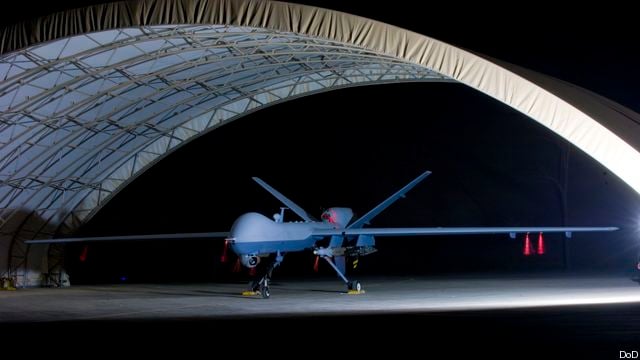 PENTAGON: The top US commander the Middle East wants an infusion of $371 million to buy more drones, surveillance, and force protection to cover the American troop surge in the region, while indicating he’s interested in building up an emerging logistics hub in Oman.
PENTAGON: The top US commander the Middle East wants an infusion of $371 million to buy more drones, surveillance, and force protection to cover the American troop surge in the region, while indicating he’s interested in building up an emerging logistics hub in Oman.
The request is more evidence that the military, despite promises to draw down in the Middle East, continues to build up capacity in the region.
[Read all our coverage of the armed services’ and Combatant Commands’ Unfunded Priorities]
In a letter sent to Congress Thursday, Centcom chief Gen. Kenneth Mckenzie said he needs the money — which comes on top of the 2021 budget request submitted last week — to “increase our intelligence, surveillance, and reconnaissance capacity, support countering unmanned aerial systems threats, provide for base defense and resiliency, and conduct inform and influence activities against malign state actors and their proxies.”
At the top of the list is a new Reaper drone for $238 million, along with other platforms “from which to employ Gorgon Stare Wide Area Mapping Imagery sensors.” Gorgon Stare is a secretive Air Force program capable of surveilling large areas at incredibly high resolution, while tracking multiple objects simultaneously. In its ‘21 budget request, the Air Force said it wants to retain the entirety of its MQ-9 Reaper fleet, while cutting the number of combat air patrols their drone flies from 70 to 60 by scaling back on patrols that are contractor-operated.
In his letter, however, McKenzie said that a “leased solution is considered most cost effective.”
The military is also looking for more assets to track and knock down small drones that can harass US forces in the region, which have grown by about 18,000 troops this year as the Trump administration continues to pressure Iran.
These systems’ “low velocity and altitude makes them difficult to detect on radar and limited options exist in effectively defeating them,” the letter said. McKenzie asked for $67 million to buy several specific systems, including Air Vigilance, Modular C-UAS Airborne Platform Systems, land-based Phalanx weapon system, and Indirect Fire Protection Capability which “would help counter these airborne IEDs and intelligence gatherers. within a single command and control network that provides effective electronic and kinetic options for C-UAS purposes.”
Most intriguing among the list of items is not an item at all. The letter asks for $21 million to build up logistics facilities to in Duqm, Oman, a port facility US forces have been visiting more frequently.
The March 2019 Strategic Framework Agreement between the US and Oman expanded access agreements to allow American forces to use the ports of Duqm and Salalah, The Congressional Research Service wrote in January that Duqm “is large enough to handle U.S. aircraft carriers, and U.S. officials viewed the agreement as improving the U.S. ability to counter Iran.” In January, the USS Harry S. Truman aircraft carrier, along with the cruisers Ticonderoga and Normandy pulled into the port for resupply.
Fy2021 Centcom Upl by BreakingDefense on Scribd
In his letter, Mckenzie calls Duqm “the only fully capable and scalable logistics hub, outside the Arabian Gulf” that can provide distribution for all the US armed forces. The money, if allocated, would pay for expanding waterfront operations, increasing warehouse space, boat maintenance, and ammunition storage facilities. “Further development ensures Duqm supports a more efficient, flexible, and resilient USCENTCOM posture with dispersed aerial- and sea- port of debarkation capabilities that mitigate movement constraints through strategic maritime chokepoints,” he stated.
The US Air Force also uses airfields at Muscat, Thumrait, Masirah Island, and Musnanah and occasionally stores lethal munitions at the bases.
In a signal that the increased US presence in the region is straining deployed stocks of basic equipment, McKenzie also wants to buy $24 million of commercial systems like guard towers, explosive detection technologies, and anti-vehicle barriers.
The ask for more money, and more facilities, to protect US forces and stage their equipment comes as Pentagon officials continue to insist they’re looking for ways to draw down in the Middle East, while shifting focus to the Pacific to counter China.
“What I want to do is reallocate forces” to the Pacific region, Defense Secretary Mark Esper said in December at the Reagan National Defense Forum. “That’s my priority theater,” he continued, warning the US has to readjust to “compete with the Chinese, to reassure our allies and to conduct exercises and training.”
Norway’s top officer on his ‘biggest challenge,’ next frigate and new NATO neighbors
Gen. Eirik Kristoffersen, Norway’s Chief of Defense, talks to Breaking Defense about his plans for spending on new frigates and subs, the challenges of upgrading Norway’s “digital backbone” and refilling the military’s stocks.


























